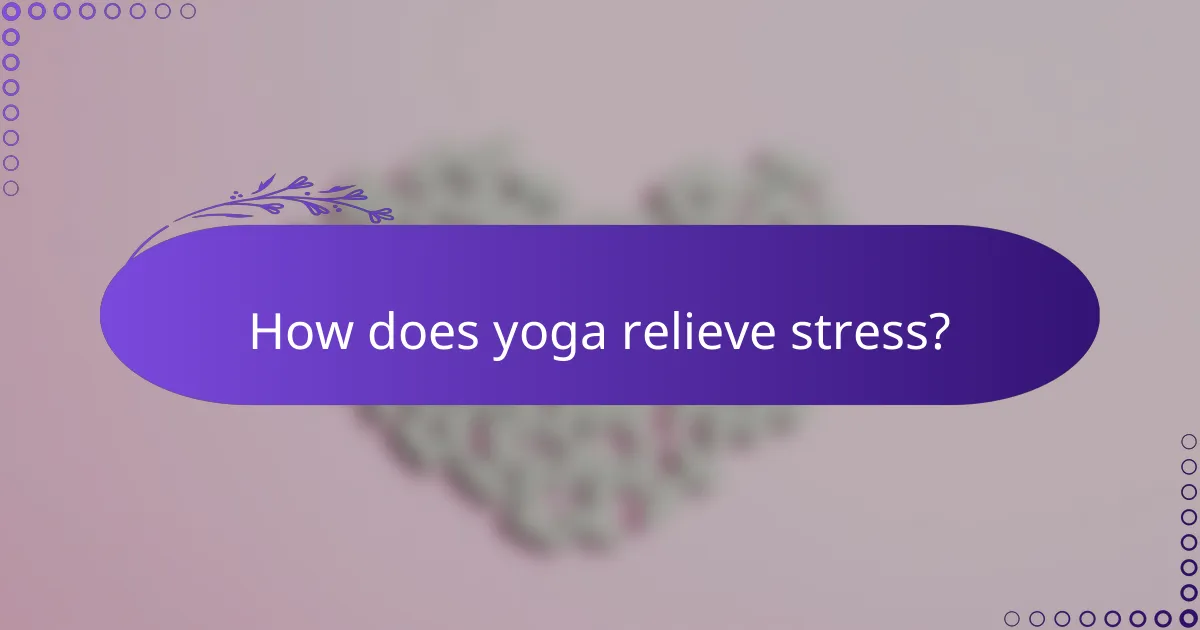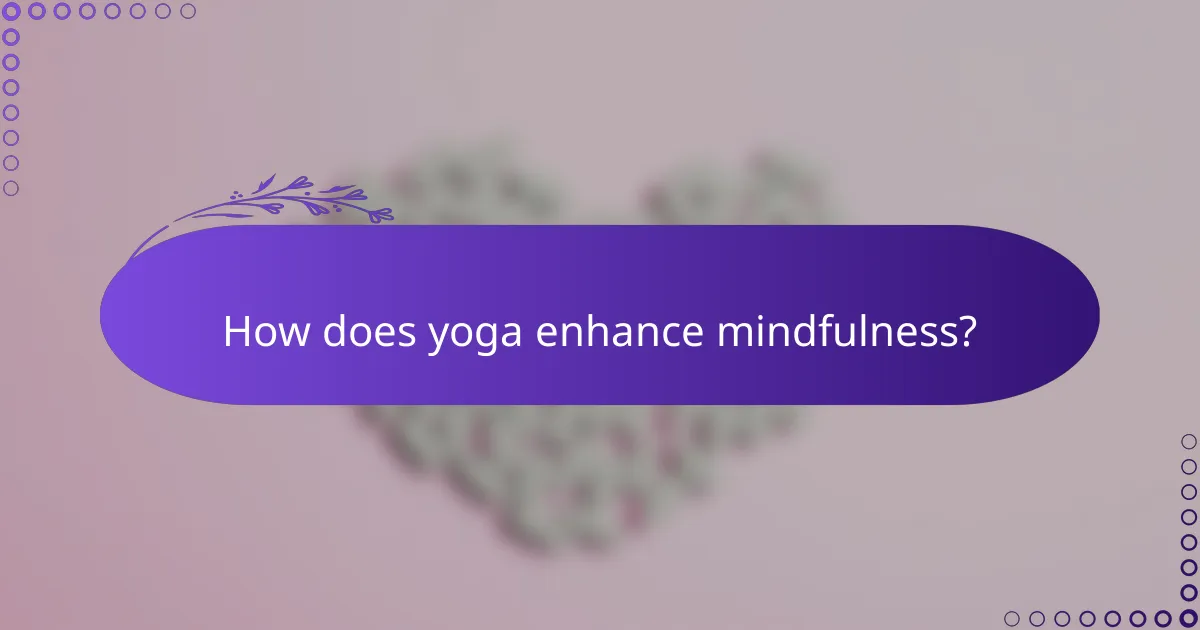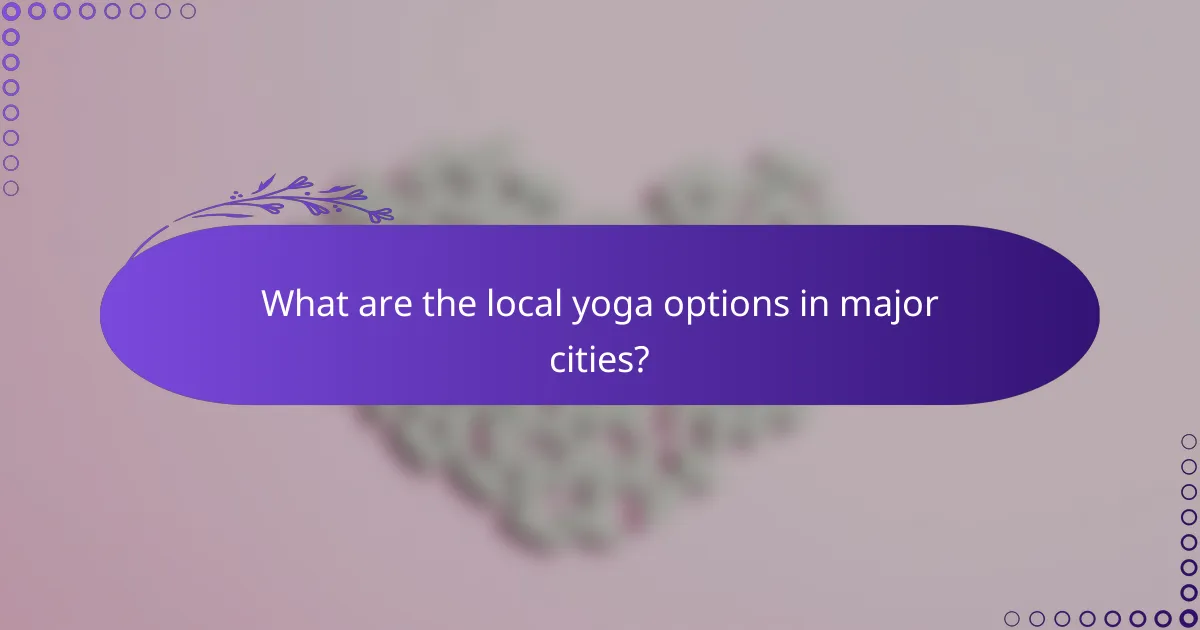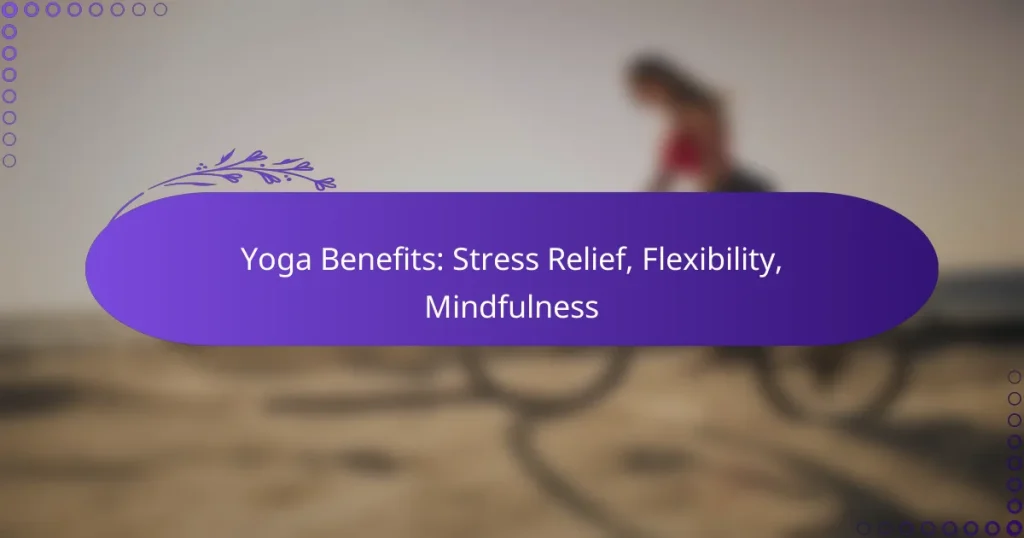Yoga offers a holistic approach to well-being by effectively relieving stress, enhancing flexibility, and promoting mindfulness. Through a combination of physical postures, breathing techniques, and meditation, practitioners can achieve a state of calm, improve their range of motion, and cultivate a deeper awareness of the present moment. Regular practice not only reduces tension but also fosters a greater understanding of oneself and one’s environment.

How does yoga relieve stress?
Yoga relieves stress by promoting a state of calm and balance through physical postures, breathing techniques, and mindfulness practices. These elements work together to reduce tension and enhance overall well-being.
Reduces cortisol levels
Yoga has been shown to lower cortisol levels, the hormone primarily responsible for stress. Engaging in regular yoga practice can lead to significant reductions in cortisol, which may help mitigate stress-related health issues.
Practices such as deep breathing and meditation during yoga sessions can enhance this effect, allowing the body to enter a more relaxed state. Aim for at least 30 minutes of yoga several times a week to experience these benefits.
Promotes relaxation response
The relaxation response is a physiological state that counteracts stress, and yoga is effective in triggering this response. Techniques like slow, controlled breathing and gentle movements encourage the body to relax and reduce heart rate and blood pressure.
Incorporating restorative yoga poses, such as Child’s Pose or Savasana, can further enhance relaxation. Consider dedicating time at the end of your yoga session to focus solely on these calming postures.
Enhances emotional resilience
Practicing yoga can improve emotional resilience, helping individuals better cope with stressors. By fostering a mindful awareness of thoughts and feelings, yoga encourages a more balanced emotional state.
Regular yoga practice can lead to increased self-awareness and a greater ability to manage stress. To build emotional resilience, integrate mindfulness meditation into your routine, focusing on acceptance and non-judgment of your experiences.

What are the flexibility benefits of yoga?
Yoga significantly enhances flexibility, which is the ability of muscles and joints to move through their full range of motion. Regular practice can lead to improved mobility, making daily activities easier and reducing discomfort.
Increases range of motion
Yoga poses are designed to stretch and lengthen muscles, which helps increase the range of motion in joints. This is particularly beneficial for individuals who may have tight muscles due to inactivity or repetitive movements. For example, poses like Downward Dog and Warrior II actively promote hip and shoulder flexibility.
To maximize this benefit, focus on holding each pose for several breaths and gradually deepening the stretch over time. Consistency is key; practicing yoga several times a week can lead to noticeable improvements in flexibility.
Improves muscle elasticity
Muscle elasticity refers to the ability of muscles to stretch and return to their original shape. Yoga enhances this elasticity through dynamic movements and sustained stretches. Poses such as Forward Bend and Cobra not only stretch the muscles but also encourage blood flow, which can aid in recovery and flexibility.
Incorporating a variety of poses that target different muscle groups can help maintain overall muscle elasticity. Aim for a balanced routine that includes both strengthening and stretching exercises to support muscle health.
Reduces risk of injury
Improved flexibility from yoga can significantly reduce the risk of injuries, particularly in physically demanding activities. When muscles and joints are more flexible, they are less likely to strain during sudden movements or heavy lifting. For instance, a flexible hamstring can help prevent tears during running or jumping.
To further minimize injury risk, always warm up before engaging in physical activities and listen to your body during yoga practice. Avoid pushing yourself too hard into stretches, as this can lead to overstretching and injuries. Regular yoga practice can serve as a preventive measure, keeping your body resilient and agile.

How does yoga enhance mindfulness?
Yoga enhances mindfulness by promoting a heightened awareness of the present moment through physical postures, breathing techniques, and meditation. This practice encourages individuals to focus on their thoughts, feelings, and bodily sensations, leading to a deeper understanding of themselves and their surroundings.
Encourages present-moment awareness
Yoga fosters present-moment awareness by guiding practitioners to concentrate on their breath and movements. This focus helps to quiet the mind and reduce distractions, allowing individuals to fully engage with their current experience. Simple practices, such as mindful breathing during poses, can significantly enhance this awareness.
Incorporating mindfulness into daily life can be achieved by setting aside a few minutes each day to practice yoga. Even short sessions can help cultivate a habit of being present, which can translate into greater awareness outside of yoga practice.
Develops concentration skills
Through various poses and sequences, yoga challenges practitioners to maintain focus and concentration. This mental discipline is built over time as individuals learn to balance physical exertion with mental clarity. Techniques such as drishti, or gazing at a fixed point, can further enhance concentration during practice.
To improve concentration, consider setting specific intentions for each yoga session. This can help direct your focus and create a more meaningful practice, reinforcing your ability to concentrate both on and off the mat.
Facilitates emotional regulation
Yoga aids in emotional regulation by encouraging self-reflection and awareness of emotional states. The combination of movement, breath, and mindfulness allows individuals to process their feelings more effectively, leading to improved emotional stability. Regular practice can help reduce anxiety and enhance overall mood.
To leverage yoga for emotional regulation, try incorporating restorative poses and breathwork into your routine. These practices can provide a calming effect, helping to manage stress and foster a sense of inner peace.

What types of yoga are best for stress relief?
Hatha, restorative, and yin yoga are among the most effective styles for stress relief. Each type offers unique approaches to relaxation, flexibility, and mindfulness, making them suitable for different needs and preferences.
Hatha yoga
Hatha yoga is a gentle introduction to the most basic yoga postures. It emphasizes physical alignment and breath control, which can help reduce stress by promoting relaxation and mental clarity. Classes typically involve a mix of poses and breathing exercises, making it accessible for beginners.
To get the most out of Hatha yoga, aim for sessions that last between 45 minutes to an hour. Focus on your breath and try to maintain a steady pace, allowing your body to ease into each pose. This practice can be particularly beneficial if you are looking to unwind after a long day.
Restorative yoga
Restorative yoga focuses on relaxation and recovery, using props to support the body in various poses. This style encourages deep relaxation, helping to lower cortisol levels and alleviate stress. Sessions often last around 60 to 90 minutes, allowing ample time for each pose.
In restorative yoga, poses are held for longer periods, often five minutes or more. This extended duration allows for a deeper release of tension. Consider incorporating gentle music or guided meditation to enhance the calming effects during your practice.
Yin yoga
Yin yoga targets the connective tissues and promotes flexibility through long-held poses. This style is slower-paced, with poses typically held for three to five minutes, allowing for deep stretching and relaxation. Yin yoga is particularly effective for stress relief as it encourages mindfulness and introspection.
To practice yin yoga effectively, focus on your breath and let go of any tension in your body. This style is great for those who want to complement more vigorous forms of exercise or simply need time to unwind. Aim for sessions of about 60 minutes to fully experience its benefits.

What are the local yoga options in major cities?
Major cities offer a variety of local yoga options, including studios, classes, and community centers. Each location provides unique environments and styles, catering to different preferences and skill levels.
Yoga studios in New York City
New York City is home to numerous yoga studios that range from high-end facilities to more budget-friendly options. Popular studios like YogaWorks and Jivamukti Yoga offer diverse classes, including Vinyasa, Hatha, and restorative yoga.
When choosing a studio, consider factors such as class schedules, instructor qualifications, and membership fees, which can vary from around $20 to $40 per class. Many studios also offer introductory packages for new members, making it easier to explore different styles.
Yoga classes in Los Angeles
Los Angeles boasts a vibrant yoga scene with classes available in various styles and settings. Studios like CorePower Yoga and The Yoga Collective provide classes that cater to all levels, from beginners to advanced practitioners.
In LA, you can find outdoor yoga classes in parks, which can enhance your experience with fresh air and nature. Prices for classes typically range from $15 to $30, and many studios offer flexible membership options, including drop-in rates and monthly unlimited packages.
Community centers in Chicago
Chicago’s community centers often host affordable yoga classes, making yoga accessible to a wider audience. Locations such as the Chicago Park District offer classes at lower rates, typically around $10 to $15 per session.
These community classes focus on inclusivity and often cater to various skill levels. Check local listings for schedules and availability, as many centers offer seasonal programs that can help you stay consistent with your practice.

How to choose the right yoga style for flexibility?
To choose the right yoga style for flexibility, consider your current flexibility level, goals, and preferences. Styles like Hatha, Vinyasa, and Yin Yoga are particularly effective for enhancing flexibility.
Hatha Yoga
Hatha Yoga is a gentle introduction to the practice, focusing on basic postures and breathing techniques. It typically involves slower-paced sessions that allow for deeper stretching and alignment, making it ideal for beginners or those looking to improve flexibility gradually.
Classes often last between 60 to 90 minutes, providing ample time to hold poses and explore variations. Look for classes labeled as “Hatha” at local studios or online platforms to get started.
Vinyasa Yoga
Vinyasa Yoga links breath with movement, creating a dynamic flow of poses. This style can enhance flexibility through continuous movement and transitions, which help to warm up the muscles and improve range of motion.
Classes can vary in intensity and duration, typically lasting from 45 minutes to 90 minutes. If you prefer a more energetic approach, Vinyasa might be the right choice for you.
Yin Yoga
Yin Yoga focuses on deep stretching and holding poses for longer durations, usually between 3 to 5 minutes. This style targets the connective tissues, promoting flexibility and joint health.
Yin classes are often slower-paced and can last from 60 to 90 minutes. This practice is beneficial for those looking to increase flexibility while also cultivating mindfulness and relaxation.


